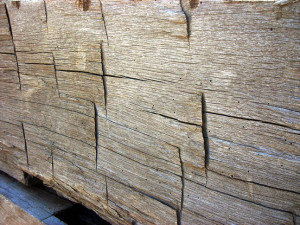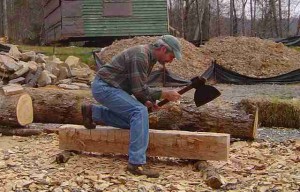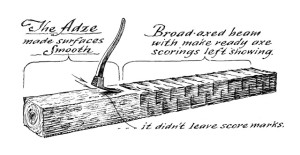Here are a few photos to look over…
The one above is of a greyed antique log that was nicely hewn with a broad axe more than a century ago.
The next photo is of a man today demonstrating how a hewn log was made with a broad axe. The major hunks have been removed by using a regular axe and then the broad axe is brought in to clean everything up nicely. Most men stand when using a broad axe.
The next photo shows an Eric Sloane drawing of the proper use of an adze which was to plane down, or make smooth, a timber that was previously hewn with an axe. It is very, very rare to find an old log cabin where someone has come in with an adze… that tool was generally saved for making the floor joists look refined. An adze is a hand plane on the end of long handle.
And the final photo, seen below, is of what you will find on many modern made cabins… where they took an adze, which is intended to make wood smooth, and instead used it to roughen the wood… creating lots of random scoop marks.
I can appreciate the desire to get rid of a rough sawn timber and to instill some handworkmanship onto the surface of a log… But I’ve found that the more people work with logs, the more they learn and practice log construction, the more they experience antique cabins… the more faux these adzed logs look…
It’s all in the details.
Remember those old commercials on tv where they had this device that would cut your hair after you hooked it up to your vacuum cleaner? A flowbee? It did the job, and to most folks it looked fine, but to those in the trade it irritated to no end… well, that’s what modern adzed logs are to old cabin guys.
Originally posted 2015-05-01 20:02:10.





Not all you write is true .I get totally different surface from adze for instance I guess that it will greatly depend on model and user .Same goes with the broad axe or any axe used in hewing thre are many ways to hew ,I am not shuar it is totally approwed to just take one method and say it is the only way. Btw gray log above seems to be hewn along grane not across or diaganally .And the new one with slightly curved narowish blade.
Hi Joe,
Thank you for leaving a comment!
(Even though you write that not everything I write is true… 🙁
I would like to know exactly what I wrote that wasn’t true if you care to be more specific. My posting was not meant to offend anyone that is an adze enthusiast… but rather to pass on what I have observed, practiced, and learned from others.
I personally have observed well into the thousands of vintage log cabins… In my decades long research and career in building and restoring cabins I’ve never seen a single log that was hewn with an axe being swung in the same direction as the grain of the log. Such a motion would be extremely challenging (and perhaps dangerous) to undertake and would cause the wood to split out far ahead of the axe work.
I’ve only seen one vintage cabin where a few of that cabin’s logs had adze marks on them… ALL the rest of these cabins were hewn with an axe. (I have seen my share of joists that were finely finished with an adze… to such a degree they looked like they were hand planed).
I do know a few craftsmen today who make beautiful cabins with an adze. They gather the logs from the forest and use an adze to flatten the two faces of the logs. I respect their work greatly… so using an axe is not the only way to build a cabin… But it is clearly NOT, by any stretch of the imagination, the traditional historic method of hewing a log cabin.
My main issue with adzes… (other than it was not the most common traditional method, or that I don’t care for swinging a sharp instrument between my legs, or the “scooped finish” look that comes often from adze work)… it is that most often today adzes are not used by craftsmen who go into the woods and use an adze to craft a log home… but by manufacturers who use an adze to rough up a precisely sawn timber and then call it the “traditional hewn look”… that, is a distortion of the truth.
Well I was way too harsh ,too quick ,too disrespectful in my comment,appolojy.
To be more specific I refered to just to finish as such represented in pictures not your knowledge of methods of log building .
I did not know that thre is practice of hewing sawn timber with adze,
using adze on ready sawn timber sounds like decorative practice anyway is it easier ,cheaper to get wood this way ?Will drying conditions ,quality of harvested wood be the same as it used to be,why not just to handplane it
My point is I just saw that picture of hewn serface and it looked like it was made by scooped adze ,somthing with round edge, stragt adze will leave different mark .And in one way or another scooped blade may be quick but it will not leave reasonable surface.
I defenetly agree with you the if reboulding restoration is historical ,it has to be done with as similar tools as possible and as similar method with as similar material .It is not only look but preserving tradition and history.
As well is old methods and ideas may have surprising effectiveness and can be applied elsewhere as working principles.
Then this old log is interesting, what are those totally vertical straight marks on the serface wich is otherwise rather uniform.Thought they’re so far apart that is difficult to imagine trajectory of the swing.
Well I am aware that on big or rather long log or board it will be rather difficult to swing totally along grane .
Then again levelling ,hewing ready wall in Finland for instance thay had ,have this practice, but still itI is slightly diagonal swing that leaves sort of wawy serface with visible exit mark of the sligtly curved blade
Back to tne photo Is it axe used on the manner of plane or plane that was used over axe finish .?
Or it is just picture angle.
🙂
Joe… the grey, hewn, log was likely created first by a man going down the length of the log with a standard axe making angled chops, regularly spaced apart. And then he would switch to a broad axe (one with a beveled one-sided edge on it) and hew a nice flat surface on the log. I’ve seen some hewing such as in this log where the broad axe marks are barely visible (a sign of a talented ax man and wonderful wood grain), but typically I find the broad axe marks at a 45% angle where the axe stops it’s swing.
I agree with everything you say… the scooping adze is typically used by the log cabin manufactures to give the illusion of hand tool work on sawn logs… but the result (to this old man at least) is rough wooden ocean.
“old methods and ideas may have surprising effectiveness and can be applied elsewhere as working principles.”…. well said! (I wish I had said that!)
Thank you for the info 🙂
Wow !This log is really smooth ,somting to learn from.
Side axe is defenitly one to try!
I am going to give hewing out some logs a try. My ash trees in my yard were killed by emerald ash borer, and I now have logs laying on the ground. I had the thought of remodeling my house, and using some for a post and beam type appearance and using these ash trees for that. I am thinking of cutting them square with an Alaskan chainsaw, and then giving them a hewn log look by going over them with a flat adze. I have an antique adze ordered through E-Bay and thought I would give it a try. However, I think the cupped out picture of the fake hewn beam looks terrible. Any thoughts on how I should proceed? Will cutting square with a Alaskan sawmill and then going over with the adze work or should I consider putting some axe marks in it then using the adze? I want it to look good. Even though my standards exceed my ability, I still want to try to make it as authentic looking as possible. Thank you.
Hi Ron,
To my critical eye an adze creates a inappropriate finish no matter how it’s used.
If I had sawn logs that I wanted to look more authentic… hewn… I would first consider planing the logs to remove the saw marks… with some of the finer bandsaw mill cuts this would not be necessary, but with sawn with a chainsaw this would be an essential first step. And then next I would come in with an axe and create chop marks as seen in the hewn log image.
An adze is wonderful, and dangerous-to-use tool. One that won’t give you the look you are after.